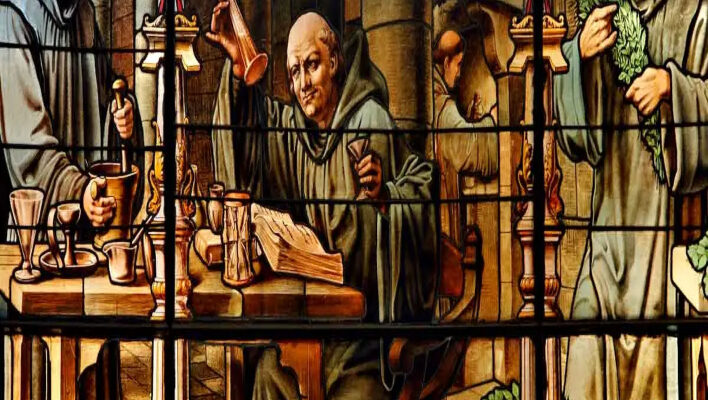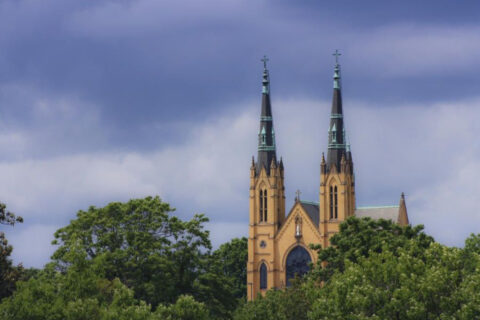The importance of Christian monasteries for the preservation of a nation’s identity is often overlooked these days in the West, but even a brief look into the relationship between the two in various countries of Christendom confirms the help that the former give to the latter.
The oldest organized European monastery was established in Bulgaria in 344 A.D., making that an appropriate place to begin. The recovery of Bulgarian independence from the Ottoman Turks was aided greatly by the building of a monastery in the 19th century:
The Arapovo Monastery of Saint Nedelya located southeast of the town of Asenovgrad is the only Bulgarian monastery built during the Ottoman rule. In the period of Bulgaria’s National Revival, it played an important role in the spiritual and cultural awakening of the Bulgarian nation.
The monastery came to life in 1856 when a monastic dormitory was created near the gushing holy spring in the area, called in Bulgarian “ayazmo”. The construction of the monastery complex lasted several years and ended in 1859. Contributing to this deed was Archimandrite Sophronius, who became the first abbot of the newly created monastery. The chief master builder was Stoyan Buradzhitski (aka Usta Stoyu) from the village of Yogovo as the Plovdiv-based Bulgarian Church Municipality which was formed in the late 1850s during the national and church struggle for Bulgarian independence also played a role in the construction.
“In 1867 a Bulgarian school was opened in the Arapovo Monastery”, explains the monastery’s acting abbot, Father Dobromir Kostov. “It had prominent enlightenment figures involved in the National Liberation Movement as teachers. According to the newspaper “Macedonia” published in Tsarigrad in this period, 60 children from the surrounding villages and about 40 poor children from Plovdiv were studying at the monastery at that time. In 1872, the Metropolitan of Plovdiv Panaret, who was also the first Bulgarian bishop appointed by the Bulgarian Exarchate, emphasized in a speech he gave that the great role of the Arapovo Monastery in the preservation of the Orthodox faith and the Bulgarian identity was its educational activity. It had a beneficial effect on the local population and helped people withstand pagan customs and superstitions. At that time, a printing workshop began to operate in the monastery, in which icons and lithographs were printed, some of them reaching as far as the towns of Prilep and Veles in Macedonia. Although it emerged late in the Bulgarian Revival period, the Arapovo Monastery of Saint Nedelya occupied a significant place in the three major lines of the Bulgarian Renaissance – new Bulgarian education, church independence, national liberation”.
For Serbia, the Hilandar Monastery on Mt Athos has been at the center of Serbian culture for hundreds of years:
Hilandar`s heritage is out of time and space. Chilandar Monastery is the first Serbian university and one of the oldest in the world. In terms of literature, religion, the study of nature, medicine, according to all of the criteria was a real university, who is trained by the best experts in these areas at this time. The monastery keeps the largest collection of Serbian charters, relics, relics of saints, old icons. Hilandar has the largest collection of miraculous icons in the world, even eight of which are the most valuable and most respected in the cristian world: the icon of the Virgin with three hands (Bogorodica Trojeručica); the icon of Christ Pantocrator, which is the most beautiful icon of Christ on the planet and icons of Holy Virgin- Odigitria, which is considered the greatest masterpiece of Byzantine art of the thirteenth century. Here is the largest library of manuscripts of the Serbian people, the largest collection of coppercut and copperwrite plates, old textiles of worship, old church plates, woodcarving works, porcelain, gold objects, crosses and the most beautiful church on Mount Athos in the judgment of Byzantine. In Hilandar was founded Serbian literacy, translation and copying activities, there is conceived Serbian medieval state of law and diplomacy, and established one of the first Serbian hospital. A place where Moravian architecture reaches its peak, through which during the last eight centuries greatest artists of icon painting and frescoes. Chilandar to the fifteenth century possessed over 30 major land`s properties – Metochia`s in Europe and Asia with over 360 villages and vast spiritual, human and material resources which can measure the power of the state.
One of the founders of Hilandar was the great St Sava. He epitomizes the blessings that can arise from monasteries for an ethnos:
. . . To all, he was a source of unity, healing, wisdom, joy, and spiritual strength, uniting the various tribes of Serbs into a cohesive nation of Orthodox believers. . .
As time passed, the tremendous legacy of holy leadership on the part of the great Sava kept the Serbian people united under one flag: the royal kingdom of Serbia which avowed Orthodoxy and the way of Christ. He was the sole person who was responsible for the transformation of the Serbian people into a people of God. And their allegiance to the way in which he lived was to the Serbs the only true model and expression of religious, political and cultural life. Hence, as in the case of every great human being who inspires generations after him to even greater heights of civilized life, so too was it with Sava, for his ideal motivated the people of Orthodox Serbia to become, in the thirteenth and fourteenth centuries, one of the most resplendent kingdoms the world has ever known. Religious life peaked as the monasteries in Serbia, the most beautiful being based upon the Byzantine style, were crowded with monastics who led an austere life, inspiring the Serbian people to greater heights of humility, while also leading them to exhibit the trait they were (and are to this day) most recognized for—hospitality. And, as mentioned, due to the astute ecclesiastical wisdom on the part of Sava in 1219 in Nicea, the Serbian Church was able, in 1346, to obtain her own autocephaly, i.e., her own Patriarch. Political and economic life also flourished, following the example of the Christ-like Sava, in the centuries following his repose in the Lord. A unity among the Serbs, based on their adherence to Orthodoxy and maintenance of the political ideals of their beloved St. Sava, allowed them to develop into a Balkan power to the point that in 1346 the Serbian King Dushan the Powerful was given the title of “Emperor of the Serbs, Greeks, Bulgars and Albanians.”
In sum, after his death St. Sava was to the Serbs a type of ideal and measuring rod of what it meant to be a true Serb, which is, to be fully committed to Jesus Christ and the way of Orthodoxy. Religiously, Sava was thought of as an equal to St. Nicholas, the ideal and standard of bishops; as a humane politician, Sava was considered an equal to St. Constantine the Great, the founder of the Byzantine Empire; and, as a Great Martyr later in 1595, Sava was considered an equal to the humble St. Polycarp of Smyrna, the first Great Martyr to be burned to death (see April 27th, Burning of the Relics of St. Sava). Bless the Lord God! All these Christian traits and attainments manifested in one person! During the two centuries following his death, the person of St. Sava became the brightest star ever known to the Serbs, inspiring them to a way of life which succeeding generations have as yet been unable to recapture or match [via an essay by Fr Daniel Rogich—W.G.].
More recently from Serbia is St Peter of Cetinje, another example of the positive role monastics have in a country’s life (our thanks to Dr Matthew Raphael Johnson for mentioning him in one of his podcasts in years past):
In the Montenegran village of Njegusi was born a saint in the year 1747. The young Peter was tonsured a monk and ordained a deacon when only seventeen. The next year he traveled to Russia with his uncle, Bishop Vasilije, for studies. But after only one year the death of the Bishop motivated his return to Montenegro, where be was ordained to the priesthood and, as Archimandrite, assisted Metropolitan Sava in administering the diocese until the latter’s repose in 1781. Now began the life-work of the Saint, as be was chosen to succeed Metropolitan Sava, a position that included secular sovereignty over the Montenegran Serbs.
For fifty years he labored to fulfill his secular and spiritual rule with a single ideal: to bring the quarreling clans and tribes to peace and to help them, find their unity as a people. Through discipline and work for the common good, rather than private gain – standards new to these Serbs – St. Peter helped his people rise above their feuds at a critical time in their history. He courageously waged war against Napoleon and, with daring far sightedness, charted the course of Serbian unification in their first uprising against the Turks.
During these times St. Peter continued his interrupted studies, reading in French, Italian and Russian to increase his knowledge of Orthodoxy and the world, its culture and sciences. And still this Metropolitan and Sovereign lived as a simple monk, shut up in a little cell and given over to fasting, prayer, and ascetic struggles. By his active good works, one can sense how he must have passed the hours of his monastic seclusion: only inspired faith and love, purity and meekness can give birth to such peace as St. Peter’s life contributed to his entire nation. He ruled like an apostle, constantly seeking love and peace, and never troubling his conscience by sentencing a miscreant to death. He pacified a stubborn, primitive and unruly people who had refused to bow to the mightiest powers on earth.
On October 18 (o.s.), 1830, the Metropolitan and ruler of Cetinje and all Montenegro, Peter, died quietly in old age. Having succeeded his uncle, he was now succeeded by his nephew, the bishop-poet Peter II (Njegos), who continued local devotion to the Saint, uncovering his intact and myrrh streaming relics in 1834. Having once suffered with his people, St. Peter now consoled them, for from his relics flowed that same paternal love which he carried within him during his life.
In a fitting testimony to the efficacy of St. Peter’ s tireless efforts to retain and strengthen the common spiritual essence of the Serbs, they now honor him with one accord as their protector, giving to the whole Orthodox Church a strong and fatherly intercessor.
St Peter’s last recorded words are heart-warming:
I have nothing to hide as my last moment approaches and I will leave this world.
I recommend you to live in harmony, dear knights and honest heroes!
Give my regards to the Montenegrin brothers and tell them that although their Ruler went to eternity, his one and last wish was that his free Montenegrin brothers defended their inherited freedom in peace and fraternal love and not to forget they were Montenegrins and free heroes.
In the martyred and wretched but free country I lived my feeble youth and gray-haired age. God’s will is for you to live forever, but do not forget my words.
Farewell free mountains and let your glory never fade! God bless you and the whole Serb kin! Take me to my chamber that I may give my spirit to higher providence.
The Primary Chronicle, or the Tale of Bygone Years, which forms the backbone of Russian history, was largely the result of the work of the holy monk St Nestor of the Kiev Caves Monastery, who reposed about the year 1114.
Russia’s uprising against her Tatar conquerors began in 1380 at the Holy Trinity Monastery with the blessing of St Demetrius Donskoy by the extraordinary monk-abbot St Sergius of Radonezh.
The monastic Patriarch of Russia St Hermogenes (+1612) likewise inspired the Russian people to rise up against their invaders during the Time of Troubles while he was imprisoned in the Chudov Monastery. His penitential prayer for Russia during those days is worthy of being repeated by us Southrons:
O Lord God Almighty, look upon us Thy sinful and unworthy children, who have transgressed before Thee, and have angered Your goodness and provoked Your righteous wrath, shed Your loving kindness on us, who have fallen deep into sin. See, O Lord, our infirmities and spiritual afflictions, know the corruption of our minds and hearts and the poverty of our faith, our falling away from Thy commandments, the multiplication of discord in our family, and the division and strife in the Church, You see our sorrow and grief proceeding from sickness, famine, floods, fires, and civil strife.
But, O Merciful and Man-Loving God, enlighten, instruct and have mercy on us, unworthy ones. Amend our sinful life, put an end to divisions and discord, gather the dispersed, unite the contentious, give peace and prosperity to our country, deliver it from discord and misfortune. O All Holy Lord, enlighten our minds with the light of the Holy Gospel, ignite our hearts with the flame of Your grace and direct them to the fulfillment of Your commandments, so that All-Holy and glorious name of the Father and the Son and the Holy Spirit may be glorified in us, now and ever and unto the ages of ages. Amen.
Turning to England, Wearmouth-Jarrow Monastery, where St Bede, the great historian and Scripture commentator, labored, was an important center in establishing Christianity amongst the English people.
Peterborough Abbey, also in England, had an excellent library and important relics and figured in the resistance against the Normans when they invaded.
Time and again, monasteries have proven themselves to be invaluable for guarding and strengthening the identity of a country. We have touched on a few instances, but others have gone unmentioned. Like those countries, the Southern people and our culture would be immeasurably strengthened by an expanding number of monasteries in Dixie. As they have elsewhere, the monks and nuns would raise our culture to a higher level – deepening our historical memory, helping guide the young and old, preserving the riches of our cultural past, producing remarkable new cultural artefacts, raising excellent leaders, and providing formidable resistance to the foes of the South (and still, all of this pales in comparison to the main benefit of monasteries: preparing souls for the Kingdom of Heaven).
Monastic life has been present in the South for many decades (see the lists here and here, for example; one of the most interesting is one of the newest, as it is located in Andrew Lytle’s home town of Monteagle, Tennessee); it is not an exotic institution, foreign to the Southern people, although it has not made much of an impression on the culture thus far (though there are exceptions).
However, considering the broader history of Christian monasticism in the world, for those pondering ways to significantly help the South, establishing a network of explicitly Southern monasteries would be one of the most consequential projects they could undertake.
-By Walt Garlington

O I’m a good old rebel, now that’s just what I am. For this “fair land of freedom” I do not care at all. I’m glad I fit against it, I only wish we’d won, And I don’t want no pardon for anything I done.






I’m starting to get tired of opening Identity Dixie, only to find Identity Orthodox. Orthodoxy is not, and will never be, part of our Southern heritage. What are the editors doing at this site? It used to produce good Southern commentary, but the last six months the ball has been dropped.
Then leave because Orthodoxy is growing in the South and the United States as a whole. It is the fullness of the faith and the only true church.
Lol…No, he’s free to stay, and honestly, Oriental Orthodoxy adherents in the South couldn’t fill the Daytona Speedway on a Sunday. It’s an anomaly in the South. No offense.
The South is distinctly Protestant and Roman Catholic, and always will be. Our Southern heroes were and are, almost exclusively.
While the Orthodox Church is a small minority, it is growing.
I think the Orthodox Church has many things about it that would be relevant to many Southerners, including respect for tradition. As you may know, our ancestors were all Orthodox, until the Romans broke away in 1054 AD.
BTW, the Oriental Orthodox are a different group, in schism with the Orthodox Church.
Thanks for your comments, I’ll pass them on.